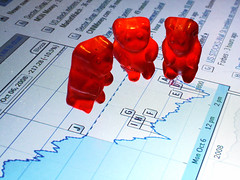From the Subprime to the Terrigenous: Recession begins at Home
Gavin Putland’s excellent new report, being picked up by all sorts of websites and e-news services
Background
The American word “subprime” refers to the credit-worthiness of borrowers. But that wasn’t supposed to matter, because if the borrowers defaulted the lenders could simply sell the collateral to repay the loans. The scheme came unstuck because the collateral was residential property, which was overvalued due to a speculative bubble. When the bubble popped, borrowers owed more than the collateral was worth, so that lenders couldn’t collect and therefore couldn’t re-lend — for housing or anything else. Thus the financial system communicated the housing crash to the rest of the U.S. economy.
What is commonly called a “property” bubble or “housing” bubble is actually a land bubble. A building is worth no more than the cost of producing an equivalent building, and loses value due to deterioration and obsolescence. But land does not have a production cost, and its locational value tends to increase due to improvements in location-dependent services. Moreover, from the viewpoint of private entities, the overall supply of land is fixed, as is the supply that can be legally used for any particular purpose, and the supply within acceptable distance of any particular services, infrastructure, or markets. Yet access to suitably located land is essential to economic participation. So land values are competed upward until they absorb the economy’s capacity to pay. In a growing economy, one should therefore expect land values to rise. But rational expectations periodically give way to belief in the greater fool: rising prices attract buyers who expect to sell at still higher prices, and that expectation becomes the sole support for current prices. Banks create credit against speculatively inflated prices and, in so doing, facilitate further inflation.
Eventually the illusion becomes unsustainable: the bubble bursts. At first, the “burst” is manifested as a fall in turnover while prices flatten out, as prospective sellers refuse to take losses. This in itself can be enough to cause a recession, not only because builders and developers slow down while waiting for unsold stock to clear, but also because slower sales cause a credit contraction by frustrating the sellers’ plans to repay loans. If sellers cannot wait for the market to meet their expectations, prices are forced down, leaving other borrowers with negative equity, in which case the credit crunch and recession are obviously worse.
The word “subprime” is therefore a distraction. Yes, loose lending helped to pump up the U.S. housing bubble; but rising collateral values came first, and loose lending was the response. Moreover, not all of the loose lending was to subprime borrowers (to say nothing of those “subprime” borrowers who met all the criteria of higher-rated borrowers, except the unwritten one concerning skin colour).




Flaubert said-: ‘the beginning of all wisdom starts with hating the Bourgeoisie’, I suspect that the ever since 1793 they just got bankcards, they said why bother hating them, lets just join them, and as french philosopher Baudrillard would say, the proles ‘simulated’ the lifestyles of celebs and middleclass, The word Subprime’ simply replaced the word Proletariat in class politics